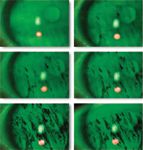Article
Managing dry eye disease now and in the future
Our understanding of dry eye has evolved and improved dramatically, as well as our ability to diagnose and treat this multi-faceted disorder. Despite its prevalence, estimated at 11% to 22% of the general population,1 dry eye is not always easy to diagnose differentially from other ocular surface disorders. Without accurate diagnosis, patients may not receive the proper treatment and education they need.
Our understanding of dry eye has evolved and improved dramatically, as well as our ability to diagnose and treat this multi-faceted disorder. Despite its prevalence, estimated at 11% to 22% of the general population,1 dry eye is not always easy to diagnose differentially from other ocular surface disorders. Without accurate diagnosis, patients may not receive the proper treatment and education they need.

Diagnostic tool box
Identifying situations that can challenge tear film integrity is also important for evaluating dry eye. Exposure to arid or windy environments, forced-air heating and cooling systems, dehydration, or extended visual tasking, such as reading and computer use, can all cause some degree of discomfort in most individuals. In these situations, patients with a predisposition to dry eye may have a greater degree of ocular surface drying and thus enhanced signs and symptoms of dry eye.
Symptomatic evaluations. Identification of a patient's chief complaint is the foundation of diagnosis and evaluation of any disease. The causes of dry eye are numerous, and, correspondingly, the symptoms of dry eye also can vary. Patients should describe their symptoms without any verbal or non-verbal cues from the practitioner to obtain uninfluenced reports. Patients with dry eye have been known to report symptoms or a combination of symptoms, including burning, stinging, excess watering, blurred vision, redness, grittiness, foreign body sensation, photophobia, and pain. Listen carefully to your patients-they are trying to tell you their problem.
Multiple questionnaires evaluating dry eye symptoms and quality of life have been developed to aid in diagnosis and understanding of the progression of dry eye. Properly designed questionnaires have high sensitivity (individuals correctly identified as having dry eye) and specificity (individuals correctly identified as not having dry eye) while also evaluating severity and frequency of symptom occurrence. The McMonnies Dry Eye Index, the Dry Eye Screening Questionnaire, the Dry Eye Quality of Life Questionnaire, and the Ocular Surface Disease Index all use less than 20 questions to assess dry eye conditions.5-8 Using these types of questionnaires as a diagnostic tool should be considered. Even asking just one question can help you evaluate the patient's dry eye. For example, researchers evaluating the impact of dry eye on daily activities have shown that a majority of patients reported that their dry eye symptoms had an adverse impact on their ability to read (76%) and watch TV (51%).9




